Microstructure, Mechanical Property, and Phase Transformation of Quaternary NiTiFeNb and NiTiFeTa Shape Memory Alloys
Abstract
:1. Introduction
2. Materials and Methods
3. Results and Discussion
3.1. Microstructure Analysis of NiTi-based SMAs
3.2. Mechanical Property of NiTi-based SMAs
3.3. Phase Transformation of NiTi-based SMAs
4. Conclusions
- (1)
- The microstructures of three NiTi-based SMAs are dominated by equiaxed grains rather than dendrites. Ni45Ti51.8Fe3.2 SMA comprises a B2 austenite matrix and a Ti2Ni precipitate. In the case of Ni44Ti51.8Fe3.2Nb1 SMA, Ti2Ni and β-Nb precipitates occur in the matrix of B2 austenite. The matrix of Ni44Ti51.8Fe3.2Ta1 SMA belongs to B2 austenite, where Ti2Ni and Ni3Ti precipitates can be observed.
- (2)
- The addition of Nb and Ta elements results in the increasing yield strength of NiTi-based SMA, but leads to the decreasing plasticity of NiTi-based SMA. Furthermore, Ni44Ti51.8Fe3.2Nb1 SMA possesses a higher yield strength than Ni44Ti51.8Fe3.2Ta1 SMA, where the Nb element plays a more substantial role in strengthening NiTi-based SMAs compared with the Ta element. Nb and Ta exist in the solid solution of B2 austenite as the solute atoms, since no metallic compounds of Nb and Ta elements are observed in the case of Ni44Ti51.8Fe3.2Nb1. In particular, Ni44Ti51.8Fe3.2Ta1 SMA exhibits a steady strain hardening ability during plastic deformation.
- (3)
- All three NiTi-based SMAs exhibit a one-step phase transformation during cooling, which is involved in the transformation from B2 austenite to B19’ martensite. However, all three NiTi-based SMAs exhibit a two-step phase transformation during heating, where they are converted from B19’ martensite to the R-phase and subsequently they are transformed from the R-phase into the B2 phase. The addition of Nb and Ta elements does not change the phase transformation path of NiTiFe SMA, but it does have a certain effect on the transformation temperatures of NiTiFe SMA. As a consequence, all the transformation temperatures are diminished.
Acknowledgments
Author Contributions
Conflicts of Interest
References
- Elahinia, M.H.; Hashemi, M.; Tabesh, M.; Bhaduri, S.B. Manufacturing and processing of NiTi implants: A review. Prog. Mater. Sci. 2012, 57, 911–946. [Google Scholar] [CrossRef]
- Sun, L.; Huang, W.M.; Ding, Z.; Zhao, Y.; Wang, C.C.; Purnawali, H.; Tang, C. Stimulus-responsive shape memory materials: A review. Mater. Des. 2012, 33, 577–640. [Google Scholar] [CrossRef]
- Meng, Q.; Yang, H.; Liu, Y.; Nam, T.H. Transformation intervals and elastic strain energies of B2-B19’ martensitic transformation of NiTi. Intermetallics 2010, 18, 2431–2434. [Google Scholar] [CrossRef]
- Otsuka, K.; Ren, X. Physical metallurgy of Ti–Ni-based shape memory alloys. Prog. Mater. Sci. 2005, 50, 511–678. [Google Scholar] [CrossRef]
- Mohd Jani, J.; Leary, M.; Subic, A.; Gibson, M.A. A review of shape memory alloy research, applications and opportunities. Mater. Des. 2014, 56, 1078–1113. [Google Scholar] [CrossRef]
- Etaati, A.; Dehghani, K. A study on hot deformation behavior of Ni–42.5Ti–7.5Cu alloy. Mater. Chem. Phys. 2013, 140, 208–215. [Google Scholar] [CrossRef] [Green Version]
- Nespoli, A.; Villa, E.; Besseghini, S. Characterization of the martensitic transformation in Ni50−xTi50Cux alloys through pure thermal measurements. J. Alloys Compd. 2011, 509, 644–647. [Google Scholar] [CrossRef]
- Goryczka, T.; Ochin, P. Microstructure, texture and shape memory effect in Ni25Ti50Cu5 ribbons and strips. Mater. Sci. Eng. A 2006, 438–440, 714–718. [Google Scholar] [CrossRef]
- He, X.M.; Rong, L.J.; Yan, D.S.; Li, Y.Y. TiNiNb wide hysteresis shape memory alloy with low niobium content. Mater. Sci. Eng. A 2004, 371, 193–197. [Google Scholar] [CrossRef]
- Zhao, X.; Yan, X.; Yang, Y.; Xu, H. Wide hysteresis NiTi (Nb) shape memory alloys with low Nb content (4.5 at %). Mater. Sci. Eng. A 2006, 438, 575–578. [Google Scholar] [CrossRef]
- Shu, X.Y.; Lu, S.Q.; Li, G.F.; Liu, J.W.; Peng, P. Nb solution influencing on phase transformation temperature of Ni47Ti44Nb9 alloy. J. Alloys Compd. 2014, 609, 156–161. [Google Scholar] [CrossRef]
- Xue, S.; Wang, W.; Wu, D.; Zhai, Q.; Zheng, H. On the explanation for the time-dependence of B2 to R martensitic transformation in Ti50Ni47Fe3 shape memory alloy. Mater. Lett. 2012, 72, 119–121. [Google Scholar] [CrossRef]
- Basu, R.; Eskandari, M.; Upadhayay, L.; Mohtadi-Bonab, M.A.; Szpunar, J.A. A systematic investigation on the role of microstructure on phase transformation behavior in Ni–Ti–Fe shape memory alloys. J. Alloys Compd. 2015, 645, 213–222. [Google Scholar] [CrossRef]
- Matsuda, M.; Yamashita, R.; Tsurekawa, S.; Takashima, K.; Mitsuhara, M.; Nishida, M. Antiphase boundary-like structure of B19’ martensite via R-phase transformation in Ti–Ni–Fe alloy. J. Alloys Compd. 2014, 586, 87–93. [Google Scholar] [CrossRef]
- Kovarik, L.; Yang, F.; Garg, A.; Diercks, D.; Kaufman, M.; Noebe, R.D.; Mills, M.J. Structural analysis of a new precipitate phase in high-temperature TiNiPt shape memory alloys. Acta Mater. 2010, 58, 4660–4673. [Google Scholar] [CrossRef]
- Atli, K.C.; Karaman, I.; Noebe, R.D.; Maier, H.J. Comparative analysis of the effects of severe plastic deformation and thermomechanical training on the functional stability of Ti50.5Ni24.5Pd25 high-temperature shape memory alloy. Scr. Mater. 2011, 64, 315–318. [Google Scholar] [CrossRef]
- Santamarta, R.; Arróyave, R.; Pons, J.; Evirgen, A.; Karaman, I.; Karaca, H.E.; Noebe, R.D. TEM study of structural and microstructural characteristics of a precipitate phase in Ni-rich Ni–Ti–Hf and Ni–Ti–Zr shape memory alloys. Acta Mater. 2013, 61, 6191–6206. [Google Scholar] [CrossRef]
- Kockar, B.; Karaman, I.; Kim, J.I.; Chumlyakov, Y. A method to enhance cyclic reversibility of NiTiHf high temperature shape memory alloys. Scr. Mater. 2006, 54, 2203–2208. [Google Scholar] [CrossRef]
- Rehman, S.U.; Khan, M.; Nusair Khan, A.; Ali, L.; Zaman, S.; Waseem, M.; Ali, L.; Jaffery, S.H.I. Transformation behavior and shape memory properties of Ti50Ni15Pd25Cu10 high temperature shape memory alloy at various aging temperatures. Mater. Sci. Eng. A 2014, 619, 171–179. [Google Scholar] [CrossRef]
- Karaca, H.E.; Acar, E.; Ded, G.S.; Saghaian, S.M.; Basaran, B.; Tobe, H.; Kok, M.; Maier, H.J.; Noebe, R.D.; Chumlyakov, Y.I. Microstructure and transformation related behaviors of a Ni45.3Ti29.7Hf20Cu5 high temperature shape memory alloy. Mater. Sci. Eng. A 2015, 627, 82–94. [Google Scholar] [CrossRef]
- Hong, S.H.; Kim, J.T.; Park, H.J.; Kim, Y.S.; Suh, J.Y.; Na, Y.S.; Lim, K.R.; Shim, C.H.; Park, J.M.; Kim, K.B. Influence of Zr content on phase formation, transition and mechanical behavior of Ni–Ti–Hf–Zr high temperature shape memory alloys. J. Alloys Compd. 2017, 692, 77–85. [Google Scholar] [CrossRef]
- Prasad, R.V.S.; Park, C.H.; Kim, S.W.; Hong, J.K.; Yeom, J.T. Microstructure and phase transformation behavior of a new high temperature NiTiHf-Ta shape memory alloy with excellent formability. J. Alloys Compd. 2017, 697, 55–61. [Google Scholar] [CrossRef]
- Acar, E.; Karaca, H.E.; Tobe, H.; Noebe, R.D.; Chumlyakov, Y.I. Characterization of the shape memory properties of a Ni45.3Ti39.7Hf10Pd5 alloy. J. Alloys Compd. 2013, 578, 297–302. [Google Scholar] [CrossRef]
- Karaca, H.E.; Acar, E.; Ded, G.S.; Basaran, B.; Tobe, H.; Noebe, R.D.; Bigelow, G.; Chumlyakov, Y.I. Shape memory behavior of high strength NiTiHfPd polycrystalline alloys. Acta Mater. 2013, 61, 5036–5049. [Google Scholar] [CrossRef]
- Meng, X.L.; Li, H.; Cai, W.; Hao, S.J.; Cui, L.S. Thermal cycling stability mechanism of Ti50.5Ni33.5Cu11.5Pd4.5 shape memory alloy with near-zero hysteresis. Scr. Mater. 2015, 103, 30–33. [Google Scholar] [CrossRef]
- Schmidt, M.; Ullrich, J.; Wieczorek, A.; Frenzel, J.; Schütze, A.; Eggeler, G.; Seelecke, S. Thermal stabilization of NiTiCuV shape memory alloys: Observations during elastocaloric training. Shape Mem. Superelast. 2015, 1, 132–141. [Google Scholar] [CrossRef]
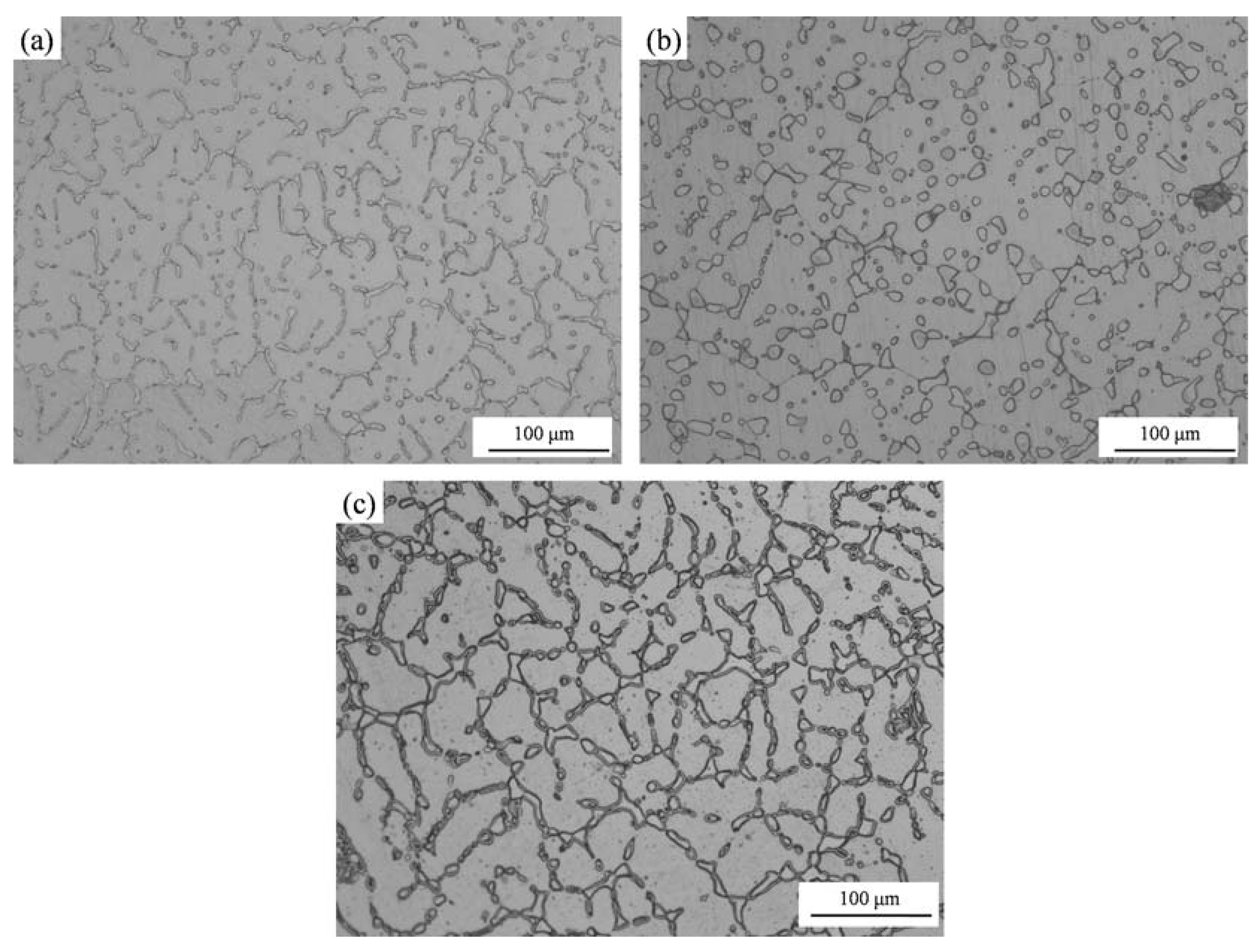
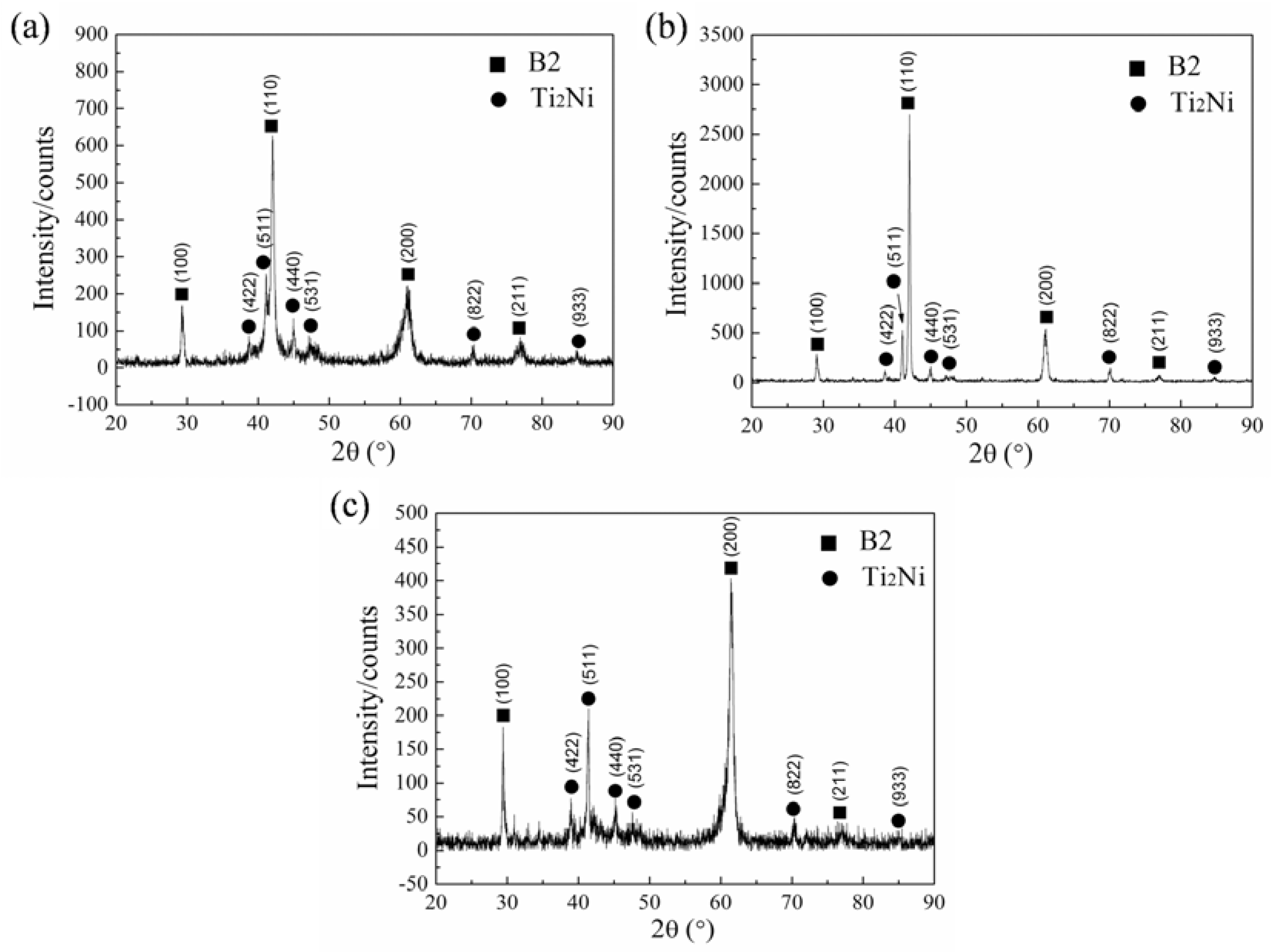

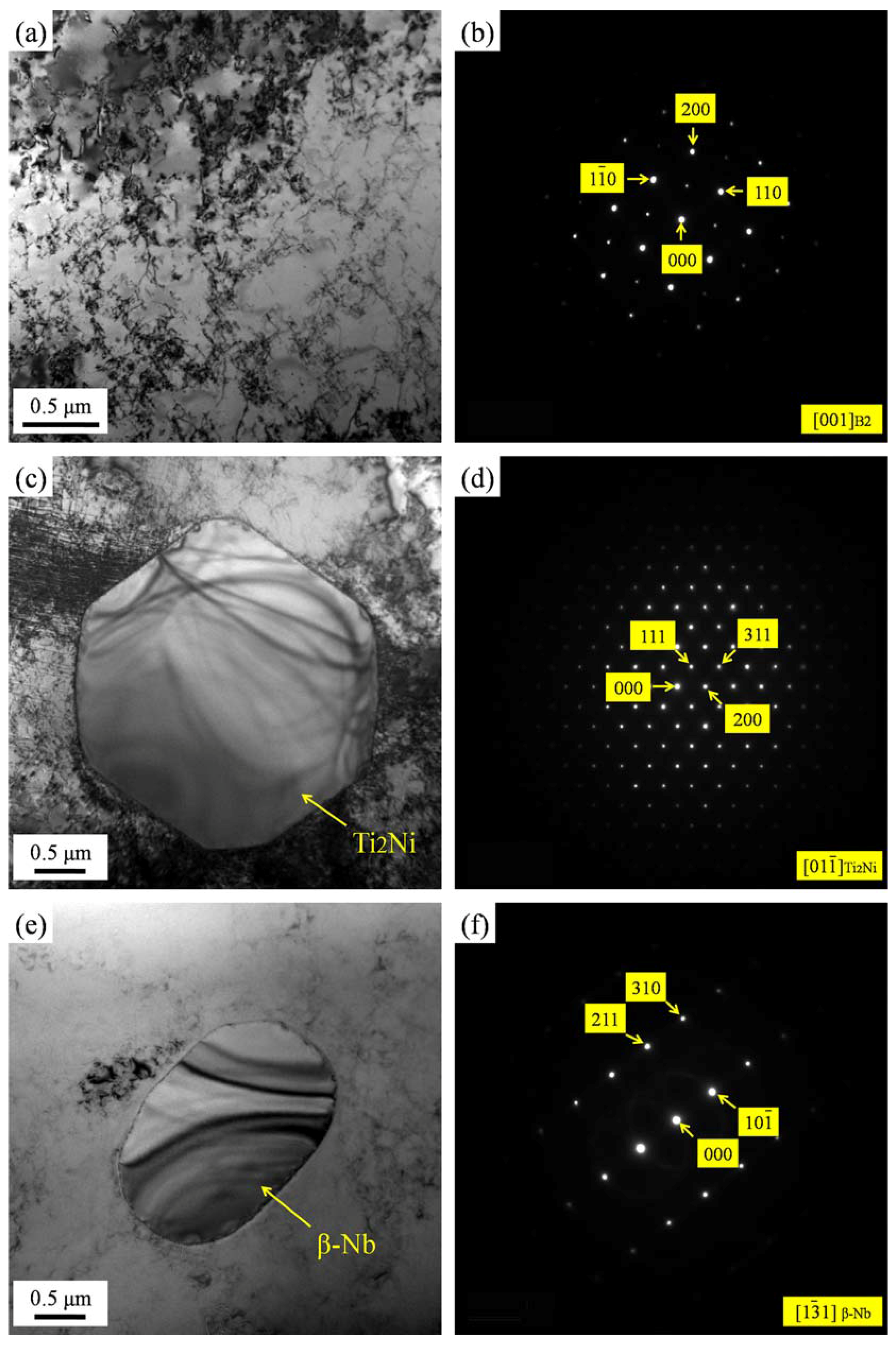
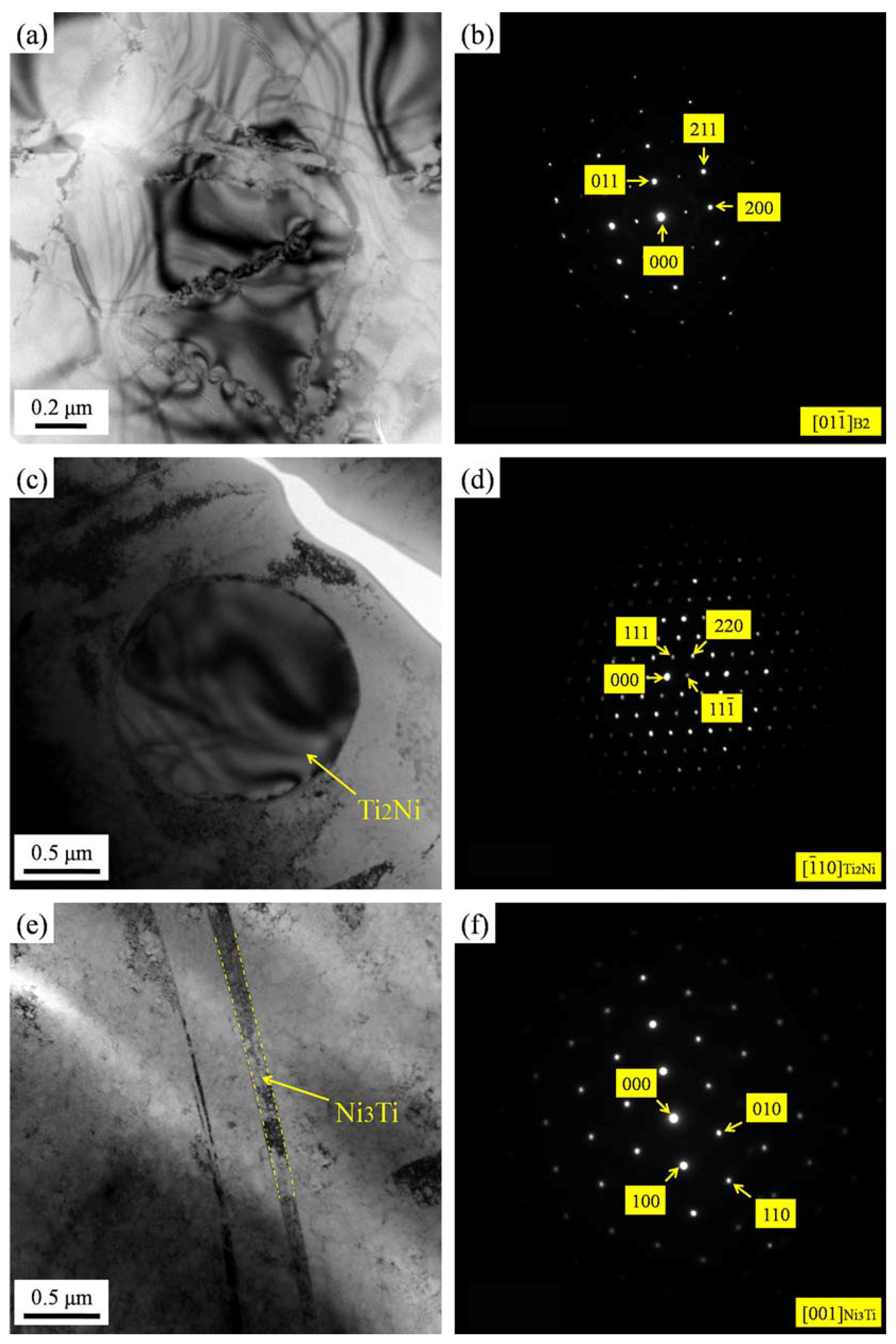
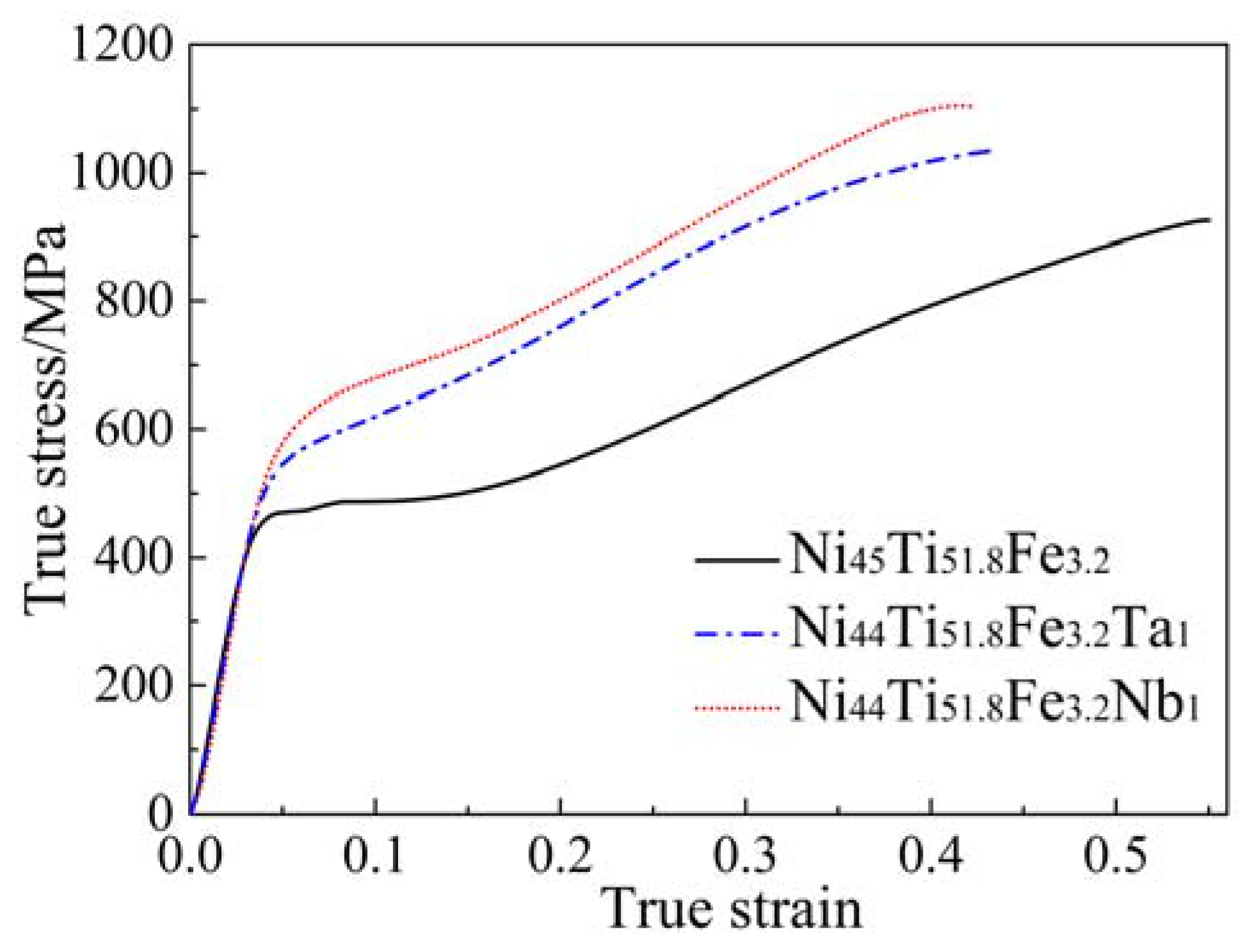
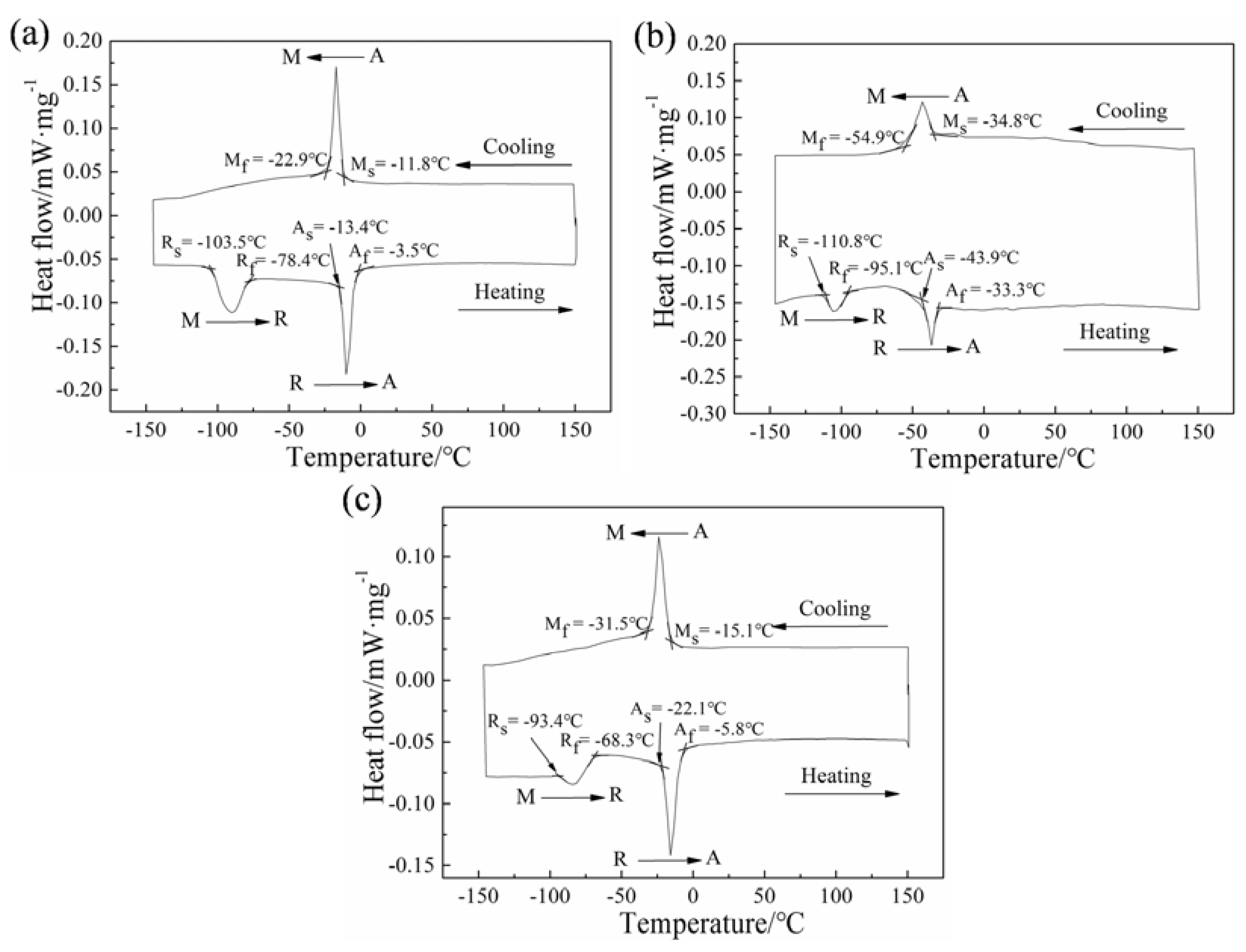
© 2017 by the authors. Licensee MDPI, Basel, Switzerland. This article is an open access article distributed under the terms and conditions of the Creative Commons Attribution (CC BY) license (http://creativecommons.org/licenses/by/4.0/).
Share and Cite
Liang, Y.; Jiang, S.; Zhang, Y.; Yu, J. Microstructure, Mechanical Property, and Phase Transformation of Quaternary NiTiFeNb and NiTiFeTa Shape Memory Alloys. Metals 2017, 7, 309. https://doi.org/10.3390/met7080309
Liang Y, Jiang S, Zhang Y, Yu J. Microstructure, Mechanical Property, and Phase Transformation of Quaternary NiTiFeNb and NiTiFeTa Shape Memory Alloys. Metals. 2017; 7(8):309. https://doi.org/10.3390/met7080309
Chicago/Turabian StyleLiang, Yulong, Shuyong Jiang, Yanqiu Zhang, and Junbo Yu. 2017. "Microstructure, Mechanical Property, and Phase Transformation of Quaternary NiTiFeNb and NiTiFeTa Shape Memory Alloys" Metals 7, no. 8: 309. https://doi.org/10.3390/met7080309



